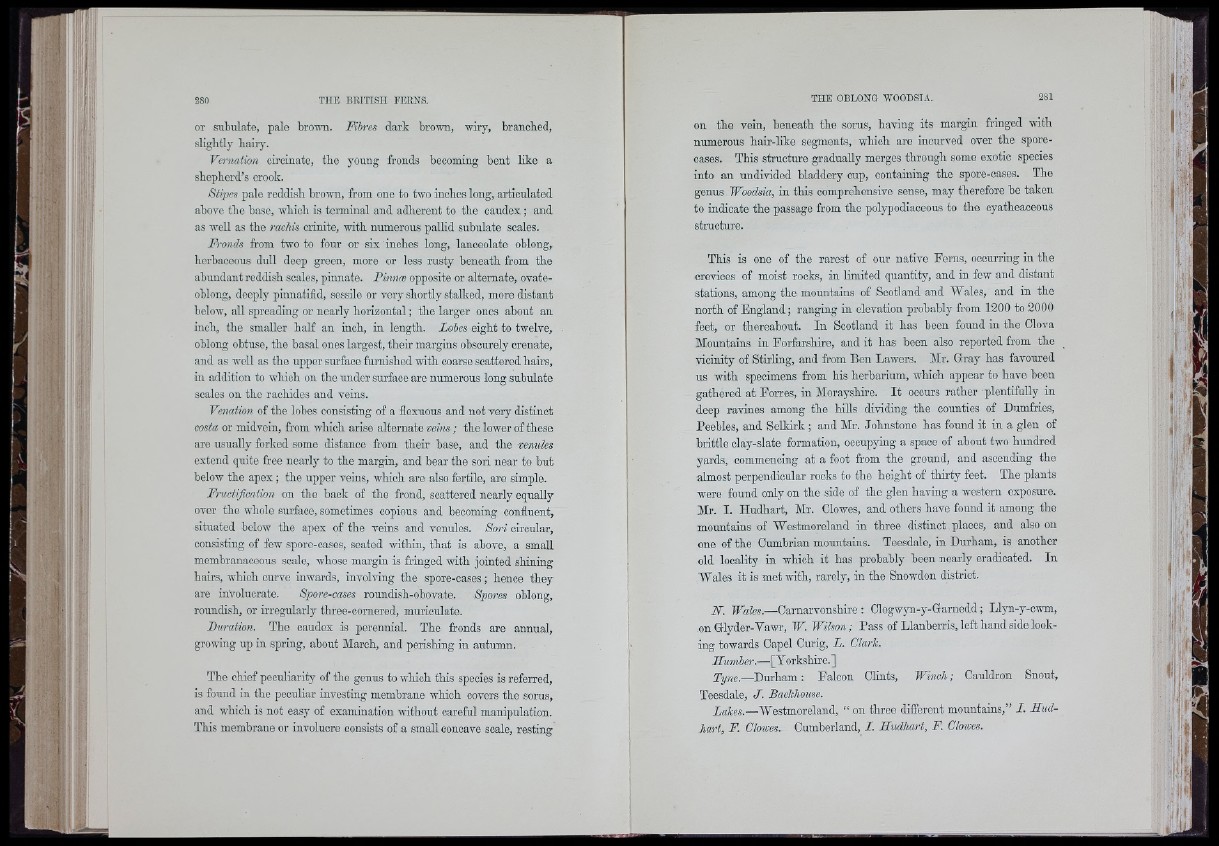
280 THE BEIT ISH FEENS.
or subulate, pale brovm. Fibres dark brown, wiry, branched,
slightly hairy.
Vernation oiroinate, the jreung fronds boooming hcnt like a
shepherd’s crook.
Stipes pale reddish brown, from one to two inches long, articulated
above the base, which is terminal and adherent to tho caudex ; and
as well as the rachis crinite, with numerous pallid subulate scales.
Fronds from two to four or six inches long, lanceolate oblong,
horbaooous duR deop green, moro or less rusty beneath from the
abundant reddish scales, pinnate. Pinnce opposite or alternate, ovate-
oblong, deeply pinnatifid, sessile or very shortly stalked, more distant
below, all spreading or nearly horizontal ; the larger ones about an
inch, the smaller half an inch, in length. Lobes eight to twelve,
oblong obtuse, the basal ones largest, their margins obscurely crenate,
and as woll as the upper surface furnished with coarse scattered hairs,
in addition to which on the under surface arc numerous long subulate
scales on the rachides and veins.
Venation of the lohes consisting of a flexuous and not very distinct
costa or midvoin, from which arise alternate veins ; the lower of these
aro usually forked some distance from thoir base, and the venuks
extend quite free nearly to the margin, and bear the sori near to hut
below tbe apex ; the upper veins, which are also fertile, are simple.
Fructification on the back of the frond, scattered nearly equally
over the whole surface, sometimes copious and becoming confluent,
situated below the apex of the veins and venules. Sori circular,
consisting of few sporc-oases, seated within, that is above, a smaU
membranaceous scale, whose margin is fringed with jointed shining
hairs, which curve inwards, involving the spore-oases ; hence they
are involúcrate. Spore-cases roundish-obovate. Spores oblong,
roundish, or irregularly three-cornered, muriculate.
Duration. The oaudox is perennial. The fronds are annual,
growing up in spring, about March, and perishing iu autumn.
The chief peculiarity of the genus to which this species is referred,
is found in the pecuhar investing membrane which covers the sorus,
and which is not easy of examination without careful manipulation.
This membrane or involucre consists of a smaR concave scale, resting
on the vein, beneath the sorus, having its margin fringed with
numerous hair-like segments, which aro incurved over the spore-
oases. This structure gradually merges through some exotic species
into an undivided bladdery cup, oontaining tho spore-cases. The
genus Woodsia, in this comprohonsivo sense, may therefore ho taken
to indicate the passage from the polypodiaceous to the cyatheaeeous
structure.
This is one of the rarest of our native Ferns, ooourring in the
crevices of moist rooks, in limited quantity, and in few and distant
stations, among tho mountains of Scotland and Wales, and in the
north of England; ranging in elevation probably from 1200 to 2000
feet, or thereabout. In Scotland it has been found in the Clova
Mountains in Forfarshire, and it has boon also reported from the
vicinity of Stirling, and from Ben Lawers. Mr. Gray has favoured
us with specimens from his herbarium, which appear to have been
gathered at Forres, in Morayshire. It occurs rather plentifully in
deep ravines among the hüls dividing the counties of Dumfries,
Peebles, and SeRdrk ; and Mr. Johnstone has found it in a glen of
brittle olay-slate formation, occupying a space of about two hundred
yards, oommenoing at a foot from the ground, and ascending the
almost perpendicular rooks to the height of thirty feet. Tho plants
were found only on tho side of the glen having a western exposure.
Mr. I. Iludhart, Mr. Clowes, and others have found it among the
mountains of Westmoreland in three distinot places, and also on
one of the Cumbrian mountains. Teesdale, in Durham, is another
old locality in which it has probably been nearly eradicated. In
Wales it is met with, rarely, in the Snowdon district.
N. Wales.—Carnarvonshire : Clogwyn-y-Garnedd; Lljm-y-owm,
on Glyder-Vawr, W. Wilson; P a s s of Llanberris, left hand side looking
towards Capel Curig, L. Clark.
Himher.—[Yorkshire.]
yy„e._Durham: Falcon Clints, Winch; Cauldron Snout,
Teesdale, J. Backhouse.
Lakes.—Westmoreland, “ on three different mountains,” J. Hud-
hart, F. Clowes. Cumberland, I. Hudhart, F. Clowes.
I',
i Í!.*
Iff-I
|t.
! !
q.fi J
(ilii
J
M